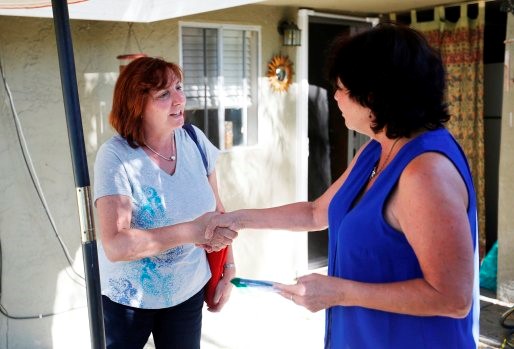Last month, we joined members of our partner organization, Sacred Heart Community Service (SHCS), to canvass in San Jose, California. The goal was to educate residents about EITC and CalEITC tax credits for which they might be eligible.
Sacred Heart and CommunityConnect Labs
Sacred Heart Community Service is one of many organizations throughout the San Francisco Bay Area and in California that serves low- and middle-income, immigrant, limited-English proficient, and other hard-to-reach households. SHCS promotes and offers free tax preparation assistance to community members, as well as a host of other social services and assistance.
For their EITC and CalEITC outreach, SHCS used a tool designed by CommunityConnect Labs that is an easily accessible, multilingual, three-minute mobile messaging tool to conduct outreach to residents for EITC and CalEITC eligibility. During the canvassing in San Jose, members of the SHCS canvassing team passed out flyers in Spanish, English, and Vietnamese detailing how to easily text into CCL’s EITC Connect tool and check one’s eligibility for EITC in only three minutes.
CCL’s EITC Connect tool has successfully connected eligible citizens to EITC and CalEITC benefits for the past three years.
Key Canvassing Takeaways
We joined two members of the SHCS team to canvass a three-block by four-block area in San Jose. Over the course of two-and-a-half hours, the canvassing team reached out to between 120 and 150 houses, with close to 30 face-to-face interactions.
For the majority of homes — ones where people weren’t present — we needed to leave them something that could help determine their eligibility and reach them where they were. For that we left a flyer with access to CommunityConnect Labs’ EITC Connect tool.
With tax season over, here are three lessons we learned for future EITC and tax preparation canvassing:
1. In-Language Outreach Is Key
In neighborhoods or cities in which English is not the primary language spoken, in-language access to tax information, whether person-to-person or through marketing materials, is absolutely critical to educating and motivating community members about the benefits that they deserve.
Staff from SHCS canvassed in Spanish and English, and had flyers in Spanish, English, and Vietnamese. Nearly one-third of the residents we met or spoke to could not speak English, but they were able to understand the canvassers’ message through the Spanish or the Vietnamese/Spanish flyers.
In-language communication and marketing materials — such as flyers and CommunityConnect Labs’ EITC Connect tool — seemed to strengthen a sense of trust in the canvasser.
2. Short and Sweet Is the Ticket
Having a direct, brief, and enticing pitch for face-to-face interactions makes all the difference.
Many residents don’t have the time, interest, or energy to speak to canvassers, or they often believe that canvassers are attempting to sell something. The canvasser needs to clearly convey their role, reason for being there, and the potential rewards (benefits) to the resident to talk to them. This can quickly resolve tension and allow for the conversation to begin.
After confirming the language needs of the community members — Spanish or English — the SHCS team members communicated in-language that:
- They weren’t selling anything;
- The resident could be eligible for thousands of dollars in tax returns;
- The resident could get free help, answers to their questions, and/or directed to the nearest free tax preparation site by texting the marketed number and activating the EITC Connect tool.
SHCS’s approach offers a strong example of maximizing canvasser time and community member attention and trust.
3. Have Resources for All Queries — or Resources to Find Out
Not everyone canvassed will be eligible for EITC, but knowing how toaddress both the eligible and ineligible is key to successful canvassing andleveraging the networks of the residents.
Many people canvassed bySHCS were interested and curious about the EITC, but they were not within theage range for eligibility. We heard the same questions.
“Are there other tax credits I might be eligible for?”
“Are there tax credits like this for people my age?”
“Can I share this with younger members of my family?”
When residents were not eligible (i.e., not within the eligible agerange), canvassers can also inquire about eligible children or grandchildrenand make sure others were not left out.
EITC/CalEITC
TheEarned Income Tax Credit (EITC) and California Earned Income Tax Credit(CalEITC) are refundable tax credits for low- to moderate-income workingindividuals and couples, particularly those with families. Many people whoqualify for EITC and CalEITC do not know about the credits, that they qualify,or how to claim the credit, whether or not they are required to file theirtaxes.

For more information on these credits, check out our previous blog post.
1 Avalos, Antonio. January 2018. “The Costs of Unclaimed Earned Income Tax Credits to California’s Economy: Update and Expansion of the ‘Left on the Table’ Report.”
2 CalEITC4Me. 2019. “EITC Facts.” caleitc4me.org/eitc-facts/.

